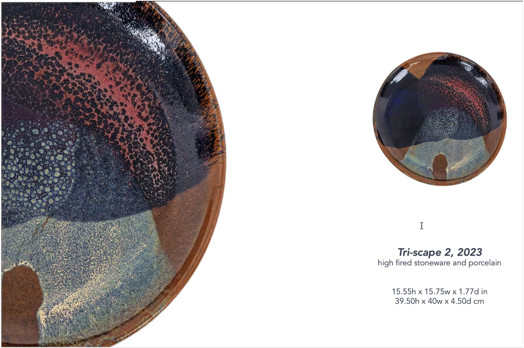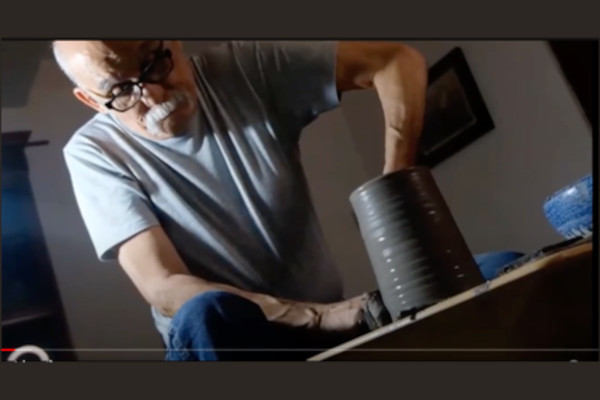Steps is Jon Pettyjohn’s third solo ceramics exhibition at the Silverlens Galleries, running until 8 July 2023. In this exhibit, the artist’s pursuit of individual expression comes to the fore in the context of working with clay and its traditions for over 45 years.

Exploring the deep recesses of the mind, the artist’s hands turn clay into works of textural and tactile force. Free from functional design, Pettyjohn’s new series of 20 wall-mounted platters of high-fire stoneware and porcelain, all done in 2023, contain a variety of abstract shapes and forms that allows the viewer’s imagination to roam, far and wide.
As he says, “I have attempted to use my pottery skills to go a little further and say something more.”
Sketches in clay

With the hand-shaped lip or rim of the platter as its frame, one encounters sketches that express the versatility of clay. Two plates with a light cream with greenish hue background, speckled, with splashes of sky blue, its ridges and furrow depict a thick swirl of a blue moon (Blue Crescent) or dispersed in three overflows of blue (Flow 1).

In three works (Triscape 1, 2, and 3), earth colors predominate, with daubs of white, dark blue, and reddish blue overlap each other against its copper background. In Crater and Pink Cloud, clay trimmings are added to form boundaries of circles in various sizes. Inside the circles, transparent and different colors of glaze overlap each other, adding textural playfulness to the whole platter.

In Crawl 1 and Crawl 2, crackle glaze (or like the crack pattern in eggshells or a web of tiny cracks) evokes a mesmerizing geometric pattern of infinity.

The only piece, Anagama Scape, done in the artist’s anagama kiln shows a cream background with a running band of greys and browns in the lower half, like a dense forest or mountain range. Is it a barrier or a promise of wilderness on the other side?
Jon Pettyjohn (b. 1950, Okinawa, Japan)

Jon, together with his wife Tessy San Juan, is considered as one of the pioneers of contemporary Philippine ceramics. Pettyjohn’s contemporary work invokes the ancient traditions of the ceramic arts of China, Korea, and Japan as well as western influences. Adapted to contemporary times, his work imparts new life into functional pieces and sculptural forms.
In 1972, Pettyjohn studied ceramics at Escola Massana, Barcelona’s municipal art and design center founded in 1929, and became an apprentice at a small shop there. When he returned to the country, only a handful of potters were around; few art galleries exhibit pottery; and equipment and materials were difficult to get.
It led him to study and experiment with local materials such as clay, stones, volcanic ash, and ash from organic materials. Amidst a wealth of local materials suitable for pottery making, he explores continuously different clays (such as from Bulacan, Quezon, Iloilo, and Bicol) with various colors, as well natural materials for making glazes.
It was in 1978 when Pettyjohn had his first solo exhibit on high-fired stoneware in Sining Kamalig in Taft Avenue, Manila. In his early years of struggle and a cycle of “hard work and trial-and-error,” he even put his potteries in a suitcase and walked around shops, trying to sell them.
In 1980, the Pettyjohns moved to Calamba, Laguna where they built their studio and residence at the foot of Mt. Makiling.
Birthing a community
When people started asking the Pettyjohns on how to do pottery, they started teaching in the mid-1980s, albeit reluctantly at first, to make a living. More importantly, it led to establishing a whole community interested in pottery, in hindsight. Their teaching and conducting pottery workshops have lasted for more than 20 years, sparking interest among young Filipinos. Many of Pettyjohn’s apprentices and students have become ceramic artists, establishing their own studios, —all contributing to a vibrant ceramic scene today. In fact, UP Diliman fine arts college has its own Ceramic Studio offering workshops to the public.
Since 2000, Pettyjohn has concentrated on wood firing using the Japanese-style anagama or cave kiln; he named his kiln, Musang-gama in honor of the musang or civet cats that live nearby. Using the anagama kiln results in rich natural glaze, resulting from the complex interaction between flame, ash, and clay minerals.
In making pottery, one can never exert total control over the various processes from cleaning and kneading the clay, shaping it by hand or potter’s wheel, trimming and decorating, bisque firing, and glaze firing. An infinite amount of patience is needed between these steps. Nature has the final say.
At the end stage of firing at high temperature, a white color may turn out to be red, blue, or green, and other unexpected changes may occur, some brilliant, others a disappointment. As Pettyjohn notes, pottery is about “anticipation because you will never see the final result until you unload the kiln.”
